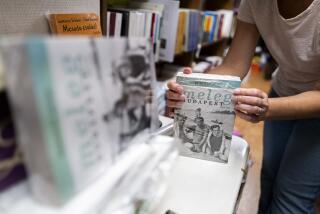Budapest, so Nouveau
Budapest, Hungary — TWO remarkable things happened in Budapest around 1900: The city shot up almost overnight, and Art Nouveau arrived, reshaping the face of Hungary’s capital along glorious new lines.
It was a happy coincidence for Budapest then and for visitors now, especially those who have a passion for Art Nouveau, which put its richly ornamental stamp on buildings, furniture, glass, ceramics, textiles and jewelry.
People make special trips to see Art Nouveau -- to Prague, Czech Republic; Paris; Brussels; and Barcelona, Spain, but they rarely think of Budapest, known more for its old castle, a medieval set piece overlooking the Danube River. Beyond it, though, another ravishing Art Nouveau Budapest awaits, testifying to the city’s blossoming and the beauty of the style that marked it.
At the time, Art Nouveau was swirling across Europe replacing such staid, derivative styles as neogothic with idiosyncratic architecture and gracefully abstracted floral motifs. It took distinctive forms in the many countries where it became popular. The style incorporated themes from folk culture and mythology in Germany, where it was known as Jugendstil. In France, where architect Hector Guimard created writhing, wrought-iron entrances to the Paris Metro, it was more floral and feminine. In Barcelona, Antoni Gaudi turned the facades of buildings into melting ice cream.
Hungarian Art Nouveau, especially as practiced by architect Odon Lechner, had an operatic, almost cartoonish flair, though the style’s various tendencies all soon arrived in Budapest and blended. It was a wide-open canvas for the modern style, a city growing like a colt economically and culturally, the Continent’s Chicago.
Today, instances of Art Nouveau are widely scattered throughout the city, which means long but tonic walks and rides on subways and trams for those seeking them.
The city’s remarkable growth -- in the 25 years that preceded the turn of the 20th century, the population tripled and the number of buildings doubled -- was spurred by a variety of factors. The Compromise of 1867 figured chief among them. It made the country an almost equal partner in a dual monarchy ruled by Austrian Emperor Franz Josef, who was crowned king of Hungary the same year. Financial institutions and foreign capital flowed into Budapest. It got a sophisticated drinking-water system, electric trolleys, an opera house, parliamentary building, broad boulevards and a city park.
From Buda to Pest
AS my plane descended last month, I caught sight of the city clustered around a sweeping Danube River S-curve, as elegant as any designed by Tiffany or Lalique. With its varied skyline, seven distinctive bridges, waterfront walkways and trams, Budapest does justice to its wide, fair stretch of the river. Old Buda decorates the hills to the west, a beguiling panorama and UNESCO World Heritage Site. Newer Pest, where most of the city’s Art Nouveau architecture is concentrated, lines the river on the east, officially united with its neighbor in 1873.
Modern Hungary joined the European Union in 2004. It has 2 million people, traffic jams and construction sites. Experts say its bubble economy has burst, and last month when Hungarian Prime Minister Ferenc Gyurcsany admitted he had lied about the state of the economy to win the election, the city erupted in protests, some of them violent.
But the turmoil remained under the surface during my visit and had further subsided last week after protests Sept. 23. So the city worked its old-world charms on me. If you visit in rose-tinted glasses, as I did, it isn’t hard to imagine civil and genteel Budapest circa 1900. Bells still tinkle in the doorways of little shops; yellow trolleys clatter along the boulevards; people spend the afternoon in coffeehouses and make phone calls from old-fashioned yellow-and-green booths.
In a minibus from the airport, I saw a complex of concrete-block apartments, an architectural legacy of the Communist era that circled other cities in Eastern Europe in high-rise housing projects. But central Budapest managed to evade large-scale desecration, practicing a somewhat relaxed form of Soviet bloc ideology known as Goulash Communism.
The city did not escape the ravages of World War II. During the 1944 siege, house-to-house battles raged between advancing Soviet troops and desperately retreating Germans. Seventy percent of the city was damaged; the Royal Palace on Castle Hill burned; all seven bridges crumbled into the Danube.
At the Gresham Palace, one of the first Art Nouveau buildings in Budapest, stained glass cracked, and an entrance gate was torn off its hinges. Miraculously, though, it survived the war.
Built by a London-based insurance company as luxury apartments, Gresham Palace has a dripping, Gaudi-esque facade, with two towers and abundant sculptural decoration. The grand entrance, with its massive, wrought-iron gate, originally led to a T-shaped shopping passage, paved in then-state-of-the-art asphalt and topped by a soaring glass roof.
It’s still thrilling to arrive at the Gresham Palace because, after years of neglect, it underwent a five-year renovation and opened in 2004 as a Four Seasons hotel. The T-shaped arcade is now a sumptuous lobby lined with pale green tiles made by Hungary’s celebrated Zsolnay Ceramics Factory. Gabor Kruppa, the architect in charge of the renovation, told me by phone later that about half the tiles were original, as were many of the exquisite stained-glass windows made by the renowned Budapest workshop of Miksa Roth.
Kruppa and his team painstakingly preserved many of the building’s late 19th century features, replacing crumbling tiles, recasting ironwork, restoring its etched and stained-glass windows. But the interior decor is contemporary, with Art Nouveau echoes, like the white-and-black mosaic floor of the lobby and elegant wood guest-room doorways. Only in the ground-floor Gresham-Venezia Cafe did they attempt to re-create the original as a tribute to a group of Hungarian artists called the Gresham Circle that met here in the 1920s.
On my first night in Budapest, I had dinner in the cafe, beginning with a glass of Hungarian Sauvignon Blanc from the Lake Balaton region. The entree was paprika chicken with spaetzle and sauce swirled across the plate in Art Nouveau fashion.
The Gresham Palace is the most architecturally distinguished among a handful of luxury hotels on the Danube Corso, a sequence of terraces overlooking the Pest side of the river that’s traversed by tram No. 2, a sightseer’s delight. Nearby are other landmarks, including the Hungarian Academy of Sciences, founded in 1825; Chain Bridge, the first permanent link between Buda and Pest, completed in 1849; and the Hungarian Parliament building.
Soon after my arrival, I toured the Parliament, a huge, neogothic homage to Westminster Palace in London that opened in 1902. With its ersatz medieval spires and statuary, it would have seemed hopelessly out of date by the time it was completed, an excellent example of everything Art Nouveau opposed.
Its antidote is the landmark Applied Arts Museum in southeast Budapest, designed by home-grown architect Lechner and opened in 1896. It is to the Parliament building what a toucan is to a turkey, a Hungarian-Moorish-Bollywood melange that always turns heads.
As you approach the museum from the nearby subway stop, its fantastical green-and-yellow ceramic tile roof and facade come into view. The tile work, arched windows, floral panels and cupolas are signatures of Lechner, who derived his unique version of Art Nouveau from India, Syria and the Hungarian countryside.
Inside, the building is as white as a clean sheet of paper, with a glass roof, twin staircases and circular galleries on the second and third floors. Most rooms are given over to temporary exhibitions, so only a sampling of the permanent collection is on display. But many objects are Nouveau gems, including a Zsolnay Factory porcelain vase in the form of a tulip, created for the 1900 world exhibition in Paris.
‘The birds will see them’
THE next day I strolled down Vaci Street, Pest’s main shopping artery, which runs south from Vorosmarty Square. Of course, I had to stop for coffee at Gerbeaud, the Belle Epoque empress of Budapest coffeehouses favored by matriarchs treating their grandchildren to chocolate torte.
The Art Nouveau style is impossible to mistake at Thonet House, originally a furniture showroom at 11 Vaci St., though passersby have to look up to get the full, dramatic effect of the facade, draped with Zsolnay Factory blue and terra-cotta-colored majolica by Lechner and his colleague Gyula Partos.
A critic once asked the architect why he bothered to give the tops of his buildings such elaborate ornamentation.
“The birds will see them,” Lechner said.
Thonet House tends to draw the eye away from little Philanthia next door at No. 9. But it’s worth stopping to study the flower shop’s lovely fin de siecle, copper-framed window and perfectly coordinated Art Nouveau interior. Every plaster and wood embellishment curves like the flowers for sale in the shop, providing a rare opportunity to see a vintage Art Nouveau ensemble together with the floral forms that inspired it.
Nearby Szervita Square has a handful of buildings that demonstrate the range of inspirations from which Art Nouveau drew and hint at how the style gradually morphed into Modernism. The Rozsavolgyi building on the west side of the traffic island has a music store and pharmacy on the ground floor, separated from the apartments above by bands of abstract patterns that look almost Native American. The building was designed in 1910 by Bela Lajta, who was influenced by Lechner and later by next-generation architects, including Frank Lloyd Wright.
I lunched that day at the Nador Hungarian Wine Restaurant, several blocks north of Gresham Palace, where I had pheasant in raspberry sauce with a glass of Villanyi Cabernet Sauvignon. The restaurant lies between the Danube River and Szabadsag Square, a pleasant greensward surrounded by buildings in a variety of late 19th century styles.
The one that interested me most was the Hungarian Postal Savings Bank, a relatively conservative work by Lechner, completed around 1900. Though the offices that occupy it were closing when I arrived, a security guard let me into the foyer to see its yellow and green plaster walls, decorated with an elegant drizzle of white.
Naturally, I wanted to take home an Art Nouveau souvenir. So late that afternoon I went shopping in the antiques stores that line leafy Falk Miksa Street, north of Szabadsag Square. Some of the shops are little more than cubbyholes, specializing in jewelry or ceramics. Others are warrens, crowded with fine antique furniture at relatively reasonable prices. I found many items I admired, including a set of six cane-bottomed Art Nouveau chairs for about $800 and a smashing Villeroy ceramic pedestal, decorated with drooping irises, for about $700.
It’s one thing to look at Art Nouveau gems in shops and museums but quite another to stay in one, as I did at the Gresham and at the Hotel Gellert the next several nights. On the Buda side of the city, at the foot of Liberty Bridge, the Gellert is a late work of Art Nouveau architecture, completed in 1918.
The hotel was heavily damaged during World War II, but the facade remains crowned by a high, conical tower, a form inspired by the traditional cloaks worn by Magyar peasants. The inside bears the marks of countless makeovers that have left it amiably mismatched and kitschy, like some Hungarian grandma’s parlor.
My gigantic second-floor double had a 20-foot-high ceiling, but at some point in the last few decades a dark, inelegant sleeping loft and built-in furniture were added. The carpet had threadbare patches, the walls were scuffed, and there was a gaping hole in the ceramic tile behind the toilet. I didn’t mind, though, because the view from the balcony was outstanding. I had only to step out there to see the glistening Danube River and Gellert Hill above it.
As a bonus, I had access to the Gellert’s vast spa complex -- with indoor and outdoor swimming pools, sun terraces, a cafe, beauty salon and massage rooms -- at the rear of the hotel. The Gellert spa is one of many in a city known for its rejuvenating waters but special because it is an Art Nouveau masterpiece, lined by glittering gold, blue and green tile.
There is a public entrance to the spa on the ground floor, but hotel guests reach it by an old cage elevator. I loved exchanging “good mornings” with the operator and soaking in the women’s 100-degree thermal pool with shy tourists and elderly Hungarian women wearing nothing but shower caps.
Behold the pachyderms
CLEAN and slightly wrinkled on my last day in Budapest, I walked the full 1 1/2 miles of Andrassy Avenue on the Pest side of the river. It is a model piece of late 19th century urban planning, patterned on Paris’ Champs Elysees. It begins near Deak Square in central Pest and ends at the threshold of City Park on Hero’s Square. Continental Europe’s first subway runs beneath it.
The sidewalks are generous, in places 140 feet wide, so habitues didn’t have to rub shoulders with hoi polloi, and there are many distractions as you stroll along: Budapest’s Postal Museum in a palatial apartment owned by a bottled-water magnate; the sumptuous neo-Renaissance opera house; and Art Nouveau Liszt Academy, on leafy, pedestrian-only Liszt Ferenc Square.
I ended up at the Budapest Zoo in City Park, which is somewhat dilapidated. But the entrance is an Art Nouveau marvel, made up of elephants supporting another conical Magyar cloak.
I stood there thinking about the happy, flushed people who must have passed through the gate at the turn of the 20th century and ogled the Art Nouveau pachyderms, which surely seemed to them as wonderful as they do now.
*
(BEGIN TEXT OF INFOBOX)
Straddling the Danube
GETTING THERE:
From LAX, Lufthansa, Air France, British, Aer Lingus and Delta offer connecting service (change of plane); restricted round-trip fares begin at $792. Budget carriers SkyEurope (www.skyeurope.com) and Wizzair (www.wizzair.com) offer low-cost fares to Budapest from various European airports.
Ferihegy Airport is about 10 miles southeast of the city center. Transfers by taxi cost about $25; by minibus, the cost is about $12.
TELEPHONES:
To call the numbers below from the U.S., dial 011 (the international dialing code), 36 (country code for Hungary), 1 (city code for Budapest) and the local number.
WHERE TO STAY:
Four Seasons Hotel Gresham Palace, 5-6 Roosevelt Ter, 268-6000, www.fourseasons.com, is an Art Nouveau landmark on the Pest side of the Danube with 179 rooms, two restaurants and a top-floor pool. Standard doubles about $400.
Hotel Gellert, 1 Szent Gellert Ter, 889-5500, www.danubiushotels.com, on the Buda side of the city overlooking Liberty Bridge, is renowned for its Art Nouveau spa, including indoor and outdoor swimming pools and thermal baths. Doubles about $180-$300, with breakfast and use of spa.
WHERE TO EAT:
Liszt Ferenc Ter, off Andrassy ut, is a pedestrian artery lined with popular cafes, including the Buena Vista, Karma, Pompeii and Menza.
Gundel, 2 Allatkerti ut, 468-4040, Budapest’s most famous traditional Hungarian restaurant.
Gerbeaud, 7-8 Vorosmarty Ter, 429-9000, is its best-known coffeehouse.
Farger, 18 Zoltan ut, 373-0078, is a contemporary coffeehouse on beautiful Szabadsag Square.
Nador Hungarian Wine Restaurant, 30 Nador u, 302-3086, in a wine cellar near the Parliament, serves excellent traditional fare and has a large selection of Hungarian wines. About $30 per person.
Central Cafe, 9 Karolyi Mihaly u, 266-2110, is a restored literary coffeehouse, first opened in 1887, with a full range of Hungarian specialties, including hortobagyi palacsinta, meat-filled pancakes generally served as a starter. About $30 per person.
TO LEARN MORE:
Hungarian National Tourist Board, (212) 695-1221, www.gotohungary.com.
-- Susan Spano
More to Read
Sign up for The Wild
We’ll help you find the best places to hike, bike and run, as well as the perfect silent spots for meditation and yoga.
You may occasionally receive promotional content from the Los Angeles Times.






